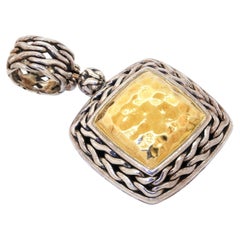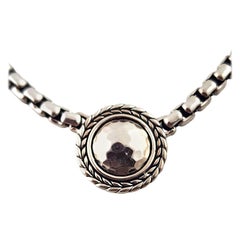John Hardy Hammered Pendant
Recent Sales
Late 20th Century Unknown Modern More Jewelry
22k Gold, Sterling Silver
20th Century Pendant Necklaces
Sterling Silver
21st Century and Contemporary Unknown Pendant Necklaces
Sterling Silver
21st Century and Contemporary Unknown Pendant Necklaces
Sterling Silver
21st Century and Contemporary Unknown Pendant Necklaces
Sterling Silver
21st Century and Contemporary Unknown Pendant Necklaces
Sterling Silver
21st Century and Contemporary American Pendant Necklaces
Gold, 22k Gold, Yellow Gold, Sterling Silver
21st Century and Contemporary Contemporary Pendant Necklaces
22k Gold, Yellow Gold, Sterling Silver, Gold
21st Century and Contemporary Contemporary Pendant Necklaces
22k Gold, Yellow Gold, Sterling Silver
21st Century and Contemporary Unknown Pendant Necklaces
Gold, Yellow Gold, 22k Gold, Sterling Silver
2010s Pendant Necklaces
2010s Pendant Necklaces
2010s Pendant Necklaces
John Hardy Hammered Pendant For Sale on 1stDibs
How Much is a John Hardy Hammered Pendant?
John Hardy for sale on 1stDibs
After John Hardy left his home country of Canada to travel the world, he settled down in Bali, Indonesia, and became one of the world’s most-lauded designers of bracelets, necklaces, rings and other jewelry.
Hardy had studied at the Ontario College of Art & Design in Toronto before he set out globetrotting. In Indonesia, he became so smitten with the people, culture and landscape that he decided to stay, and in 1975 he started selling artisan jewelry and eventually designing his own pieces through his studies of local silversmithing. From the start, the focus was on time-honored jewelry-making traditions and details of craftsmanship.
In 1983, Hardy met an American named Cynthia Boesk who also had a small jewelry business. After they married, they merged their businesses and officially started John Hardy, making a name for themselves designing elegant and eclectic bracelets that reflected centuries-old Balinese techniques. In 1998, Italian-born French jewelry designer Guy Bedarida became the creative director of the company, staying on for 16 years and leading the brand in innovative new directions. Its Bamboo collection, with designs reminiscent of bamboo stalks, directs its sales toward planting bamboo seedlings in Indonesia, while the Kali collection takes its design cues from the distinctive pebbles found in Bali.
After learning about the harmful effects that silver mining has on the environment, Hardy became extremely committed to sustainable luxury business practices, promising that every piece is conflict-free and ethically produced during each step of the design process.
In 2017, the brand was among the jewelers challenged by Vogue Italia to craft pieces from the tagua nut in lieu of using elephant ivory and has used recycled sterling silver in its designs. Its first diamond-centered collection in 2019 concentrated on ethical sourcing and mines where workers are paid fairly. Although Hardy sold his business in 2007, it continues to operate with his name and adhere to the artisanal practices he promoted, including under jewelry designer Hollie Bonneville Barden, who served as creative director from 2016 to 2020. Along with online and global retail sales, the John Hardy Workshop and flagship Kapal Bamboo Boutique in Bali also offer the brand’s enduring designs from an open-air sustainable bamboo building.
Find a collection of John Hardy earrings, cuff bracelets and other jewelry on 1stDibs.
Finding the Right Pendant-necklaces for You
Whether you’re layering multiple jewelry pieces or opting for a single strand, vintage pendant necklaces are versatile accessories that can elevate your casual wear as easily as they can add a creative flourish to your formal attire.
The earliest jewelry was less about accessorizing than it was about wearers arming themselves with amulets. In Ancient Egypt, some amulets featured a loop so that they could be strung around one’s neck. While rubies have long been one of the few gemstones that can give diamonds a run for their money, members of some ancient civilizations valued the stones from the get-go, donning ruby pendants as well as other stones with the belief that these adornments would bring protection, healing powers or strength. Today, we still wear our charm bracelets and charm pendants around our necks for good luck.
Later, pendant necklaces, like most fine jewelry, were worn strictly by royalty or the upper class and conferred wealth and prestige. This changed over time, thankfully, as wearing jewelry became more widespread, a democratized means of personal expression.
During the 18th and 19th centuries, pendant necklaces evolved from their status as spiritual amulets, but the jewels still carried deep personal significance. Victorian pendants, in particular, were part of the “mourning jewelry” tradition. Wearers would embed their pendants with locks of hair from a deceased loved one as a way of grieving in the wake of a loss. In the case of cameo jewelry, some pendants were even decorated with miniature hand-carved portraits in a detailed raised relief. Today, portraiture is still a characteristic of many of the hand-carved pendant necklaces offered by Italian jewelry house Scala Gioielli.
Luxury fine jewelry brands such as Cartier, BVLGARI and David Yurman offer their own unique interpretations of the cherished accessory, embellishing platinum or gold pendant necklaces with diamonds, sapphires and other stones.
On 1stDibs, find an extraordinary range of vintage pendant necklaces and other necklaces today.

